Typical winters are hard on birds in northern Utah (and elsewhere). But when the season is unusually frigid with lots of snow as we’re having this year they struggle even more to survive.
All of these images have been taken since January 2 of this year.
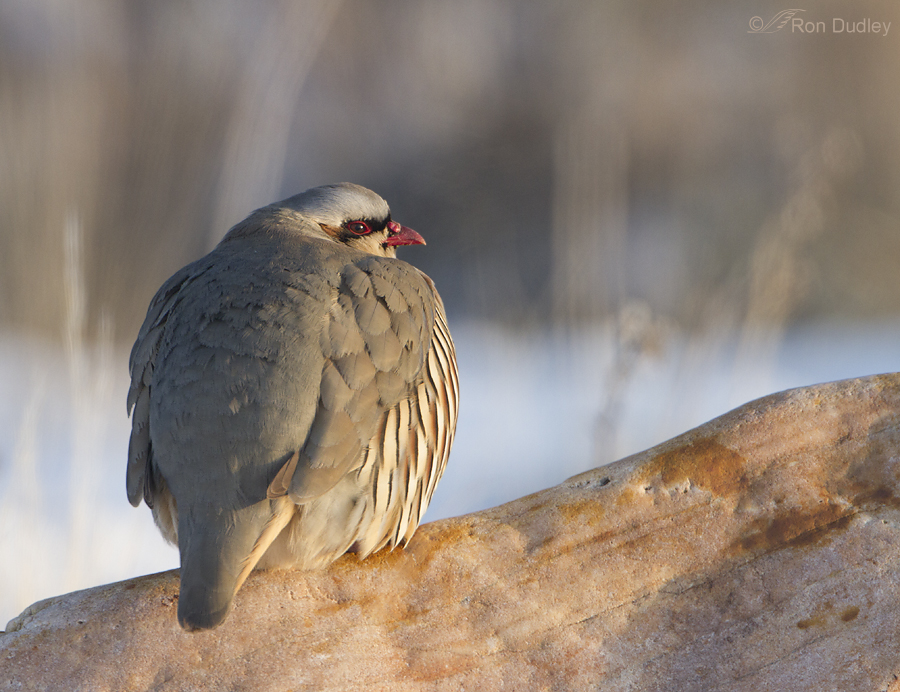
Upland game birds like this Chukar seem to have adapted to extreme conditions fairly well. This bird was all puffed up and sitting high on a rock to catch the earliest warming rays of the sun as it rose over the nearby Wasatch Mountains.
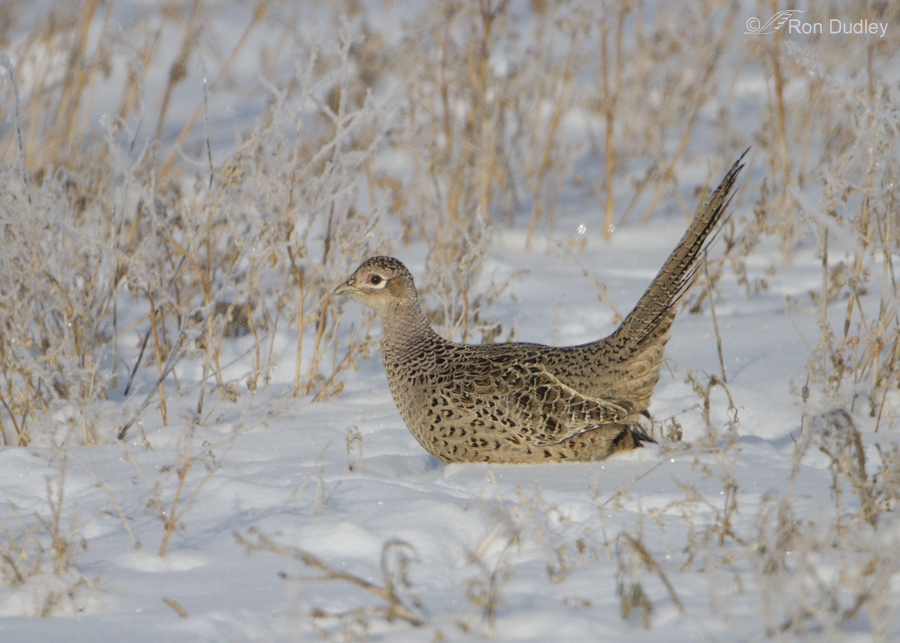
Another upland game species that can apparently take harsh conditions quite well is the Ring-necked Pheasant (this is a female). They seem to forage for seeds at the base of plants where the snow isn’t as thick and their food is more readily available.

But many other species have a difficult time and quite a few birds don’t survive until spring. The waterfowl that winter over here congregate in the few areas of open water where the flowing water is the last to freeze over. But when it gets very cold, even those small bits of open water freeze. I’ve seen ducks and coots frozen into the ice, some of them still alive. This female Green-winged Teal has just left one of the last unfrozen patches of water and is approaching an area of frost flowers.
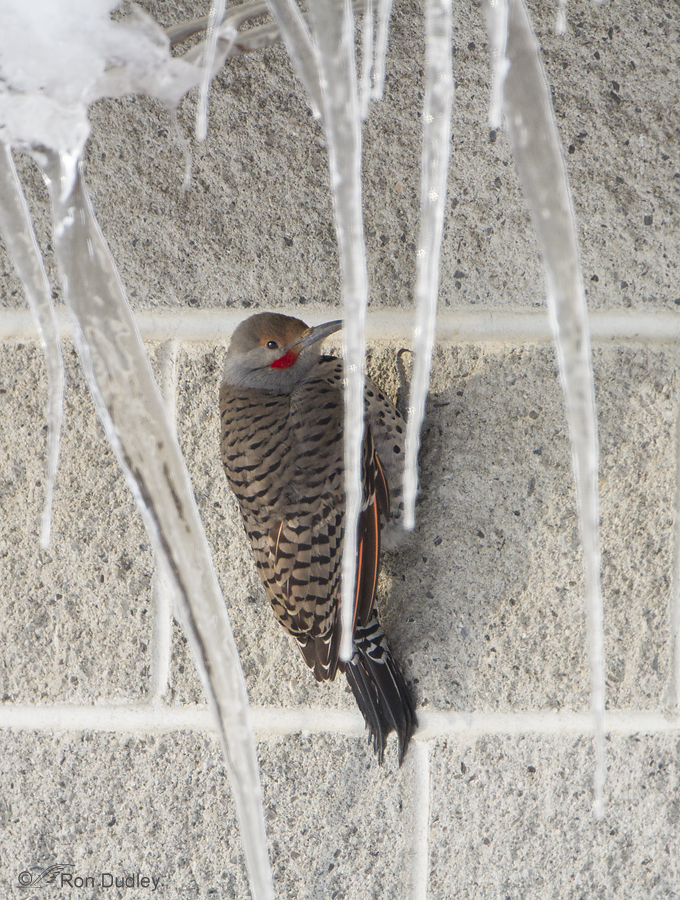
This Northern Flicker is using the protection of the underside of the eaves of a building on Antelope Island State Park. I thought the angled icicles (caused by dripping water freezing as the wind blows) were a good visual indicator of the conditions birds have to deal with.
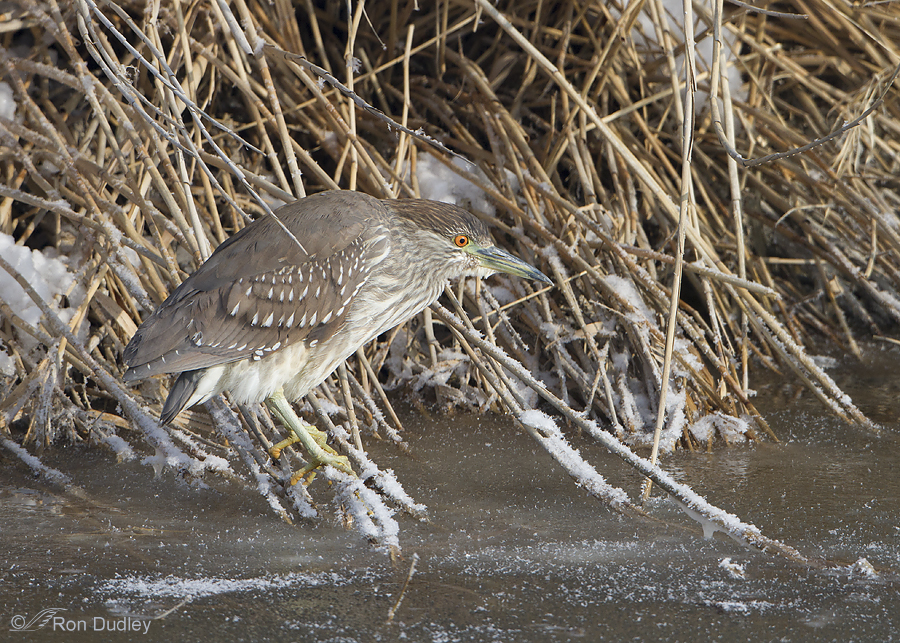
This juvenile Black-crowned Night Heron must catch fish to survive (other aquatic creatures are largely unavailable this time of year). But that’s pretty difficult to do through the ice…
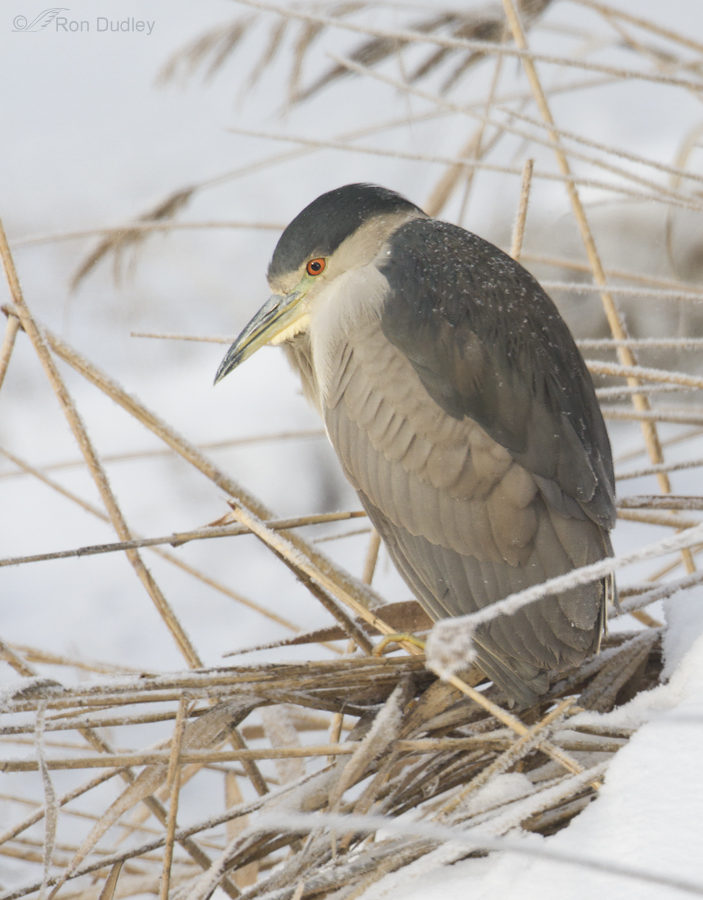
Here an adult Black-crowned Night Heron huddles in the snow with the mostly frozen pond in the upper background. Three days after this photo was taken there was a dead adult BCNH floating in the one small patch of open water left on this pond…
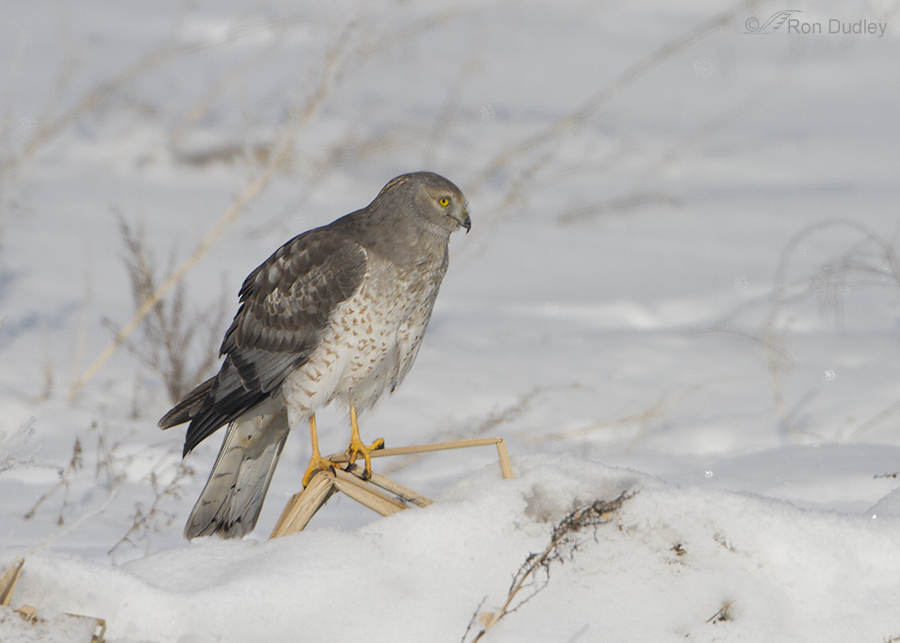
Northern Harriers really struggle to survive when the snow gets thick. They take a few small birds when they can capture them but their staple is voles. When there’s lots of snow the voles become largely unavailable. During those times they will eat carrion, including dead fish, but they tend to shun carrion unless forced to eat it by the conditions.

Roughly 12 days ago someone (most likely a photographer) placed a store-bought chicken or small turkey at the edge of a pond at Farmington Bay as a means of baiting raptors, particularly harriers and Bald Eagles), in close. I photographed at this pond for two days thinking the mound of pink flesh the birds were attracted to was a dead carp (those fish can get huge). There was a second, smaller dead fish in the area that was obviously a fish. Personally, I’m against baiting for a variety of reasons having to do with photography ethics and the welfare of birds so I’m in the process of deleting the images I have of birds that turned out to be baited except for those that I use for blog posts that document the situation.
Here the frozen chicken can be seen beneath the two fighting harriers. A large, unnatural food source like this brings in many birds and they fight ferociously over the unexpected bounty, sometimes for days. Injuries such as broken legs, wings and damaged eyes from the fighting are not uncommon – one person has documented those types of injuries five different times.
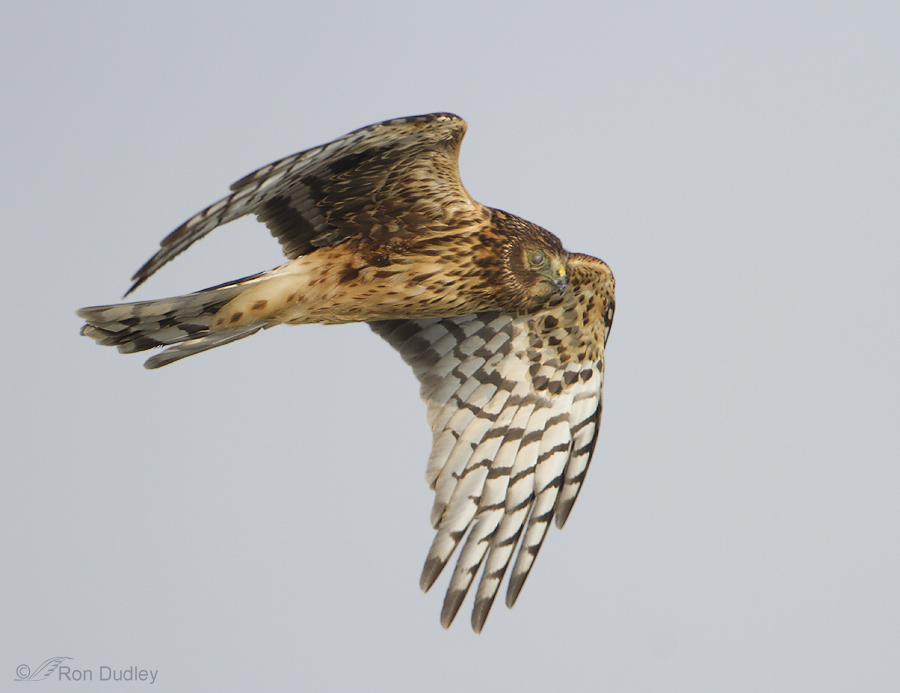
This harrier was one of the birds at the chicken bait (I’ve posted this image once before). As you can see, there’s something very wrong with its right eye. Most folks (including bird rehabbers) who have seen photos of this bird think the eye has been injured and become infected (see the comments on this post about this bird if you’re interested) and that the infection was likely to become systemic and very serious. We’ll apparently never know for sure and I haven’t seen this bird since January 2.

The American Coot is almost exclusively a herbivore but as you can see, even they will consume carrion if they have to (notice the piece of chicken flesh in the beak of the middle bird).
Opinions on the ethics of baiting differ and I can accept that, even though I don’t understand it. And then there’s the complication of just exactly what is the definition of baiting (there are gray areas). But I’m not a happy photographer when a prime spot for birds has been baited and I’m not aware it has occurred. More than once I’ve photographed in such a situation, only to find out much later that baiting was done.
Since these photos were taken the weather has turned even more harsh with much more snow and colder temperatures. The lows over the next two nights are predicted to approach zero degrees F and some areas have had 2 1/2 feet of snow (on top of what you see in these photos).
I’ll be thinking about the birds and other critters…
Ron


I appreciate the nice comments, Elephant’s Child, Maria and Fran.
…..very splendid images Ron…….mild winter here near Cape Cod, Massachusetts; at the present.
Great round-up of all the birds wintering in your area. Very informative narrative too.
It is really quite amazing that so many birds (and other animals) do survive in such harsh conditions. A triumph of adaptability. Anthromorphism or not, I find it hard not to grieve for the ones that don’t survive.
Thanks Ron, for another great series of photos. I hope you are enjoying a bit of a ‘toddy’ by the fire after those cold outings. 🙂
Oh Ron… you are the voice of these creatures in a way, with your photographs. These populations are assaulted from all sides – polluted air, poisoned water, nasty 4-wheel trucks driving over pristine habitat… how much longer are they going to last? I sometimes feel that humans are the cockroaches of the mammal world, taking over everything, going places where none should be, and of course this is terribly insulting to cockroaches (sorry)…
Thank you, Nicole. I agree – it seems like critters are assaulted relentlessly from every angle these days. I think that’s part of why many of us value them so much. I’ve always been for the underdog anyway…
Rom, I first started looking at your images of birds and being so impressed at the stellar quality of your photographs of birds in flight. If I ever took one photo in my life as good as yours I would frame it and hang it on the wall. But as time progressed, I have become fascinated with all of the aspects of bird (and animal) behavior that you write about. You are a treasure to share your knowledge and photo talents with the world. It is amazing that you have already taken so many great shots this year of various birds trying to survive in this exceptionally cold weather. What an interesting — and sometimes sad — nature story. And there you are, braving the elements, to get these shots. I can’t imagine what it is like for you! brrrrr I live in Los Angeles where 40 degrees seems too cold. We are having the coldest weather here in six years, they say. However, birds are still able to survive in what must seem like a heat wave where you are. I will continue to look forward to your outstanding images and stories.
Susan, I’m absolutely thrilled that my posts have had an influence on your appreciation of behaviors. Before I retired as a biology/zoology teacher that kind of feedback was very important to me because it indicated that I might be making a difference. Your comment reminded me of how much I loved teaching.
You should know however that I’m typically not standing out in the elements when I’m taking these photos. I photograph from my truck because a vehicle makes an excellent, mobile “blind” to shoot from which makes it easier to get closer to birds. They’re far less fearful of a vehicle than they are of a person on foot. That said, I often freeze. The windows are down and the engine off (no heater) so I’m bundled up and often using chemical hand warmers. When I got home from shooting today it took quite a while for the toes of my left foot to regain feeling.
Thank you for such a nice comment. Made me blush…
Ron, you deserve all the praise you can get! Seriously, I can’t understand how you can get such amazing photos all out of your truck!!! For example, the images of the heron and the coots look as if you were taking them at such a low angle like you were kneeling down. In addition to your photographs being sharp, great exposures and composition, you obtain terrific angles. I would sure like to see how you do it. It would be a great documentary for TV!!!
This post is a good reminder of how hard it is to make a living on this planet. I loved the images from the barn owl series that you posted long ago (morning shots of them flying over the icy grasses and plants, and perched with frost on their faces). Then I read that you realized that they were hunting so long after sunrise because they were starving–that has haunted me ever since and I think of them and their plight often. I too, hope the weather warms soon.
What a timely comment, Sharon. The Barn Owls were flying today. Lots of them. And it was mid-day, not early morning like the year you mention. That suggests to me that they are even more stressed now than they were back then.
How heartbreaking, Ron. In spite of that, I can’t help but think it would thrilling to see them and have the opportunity to get lots of wonderful photos in beautiful light. I hope their added stresses are relieved soon.
It WAS thrilling, Sharon. Absolutely! But even when they’re flying during daytime it’s still devilishly tricky to get close enough, with a good light angle, get a catch light (esp with this species with those deep-set eyes), get them sharp – all the challenges of the bird photographer. But I love it. And they’re such beautiful birds, particularly in flight.
Thank you for sharing these series of photos Ron.I’m living in Tahoe and it’s been the coldest winter so far we’ve encountered. I can’t imagine the hardships all the creatures (great and small) have to endure .
Hope it warms up sooner than later. We do put sunflower seeds out during these harsh times for the squirrels, stellar jays ,chickadees, and flickers that still linger up this high.
Thank you, John. I saw more evidence today of the stress these temps put on birds.
This is a sad story, and the photos are elegant descriptions. Feeding the birds is a debatable exercise, and one which I participate in with bird feeders in my backyard. I figure that with loss of habitat, building and automobile collisions, poisoning, domestic cats, etc, the birds have it hard enough and we should do what we can to help them. But the bird baiting you describe has other ethical dilemmas which have a definite downside. Nature can be a cruel mother.
Tana, I have bird feeders too. I think feeding passerines at a back yard feeder generally does more good for them than harm (if the feeders are kept clean).
All are great shots, Ron, but the most interesting to me was the Northern Flicker. We see them on our property is southern Louisiana, but never surrounded by such thick icicles, of course. As you noted, it tells a story.
By the way, have you decided to stop including EXIF data with your pics? Just curious, because I sometimes find these data educative.
Sorry about the EXIF data, Dwynn. No, I haven’t decided against including it (most of the time). But this morning I was in a rush because I wanted to go out shooting birds (the clouds were clearing after our storm) and I just didn’t have the time to include them.
Great series Ron. As you guys freeze this year, it’s warm again here in NJ.
Thanks, Chris – rub it in! 🙂